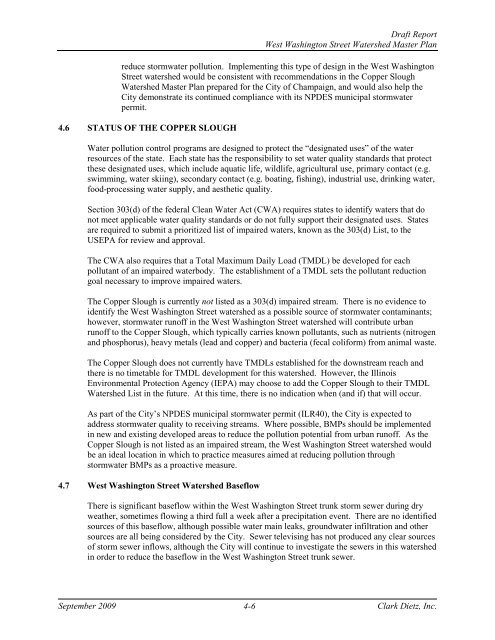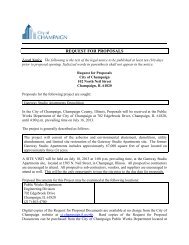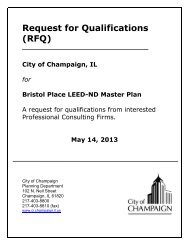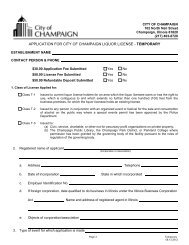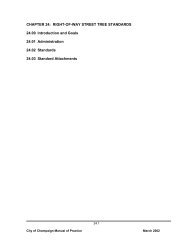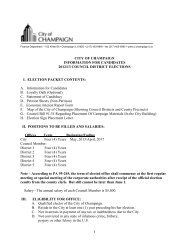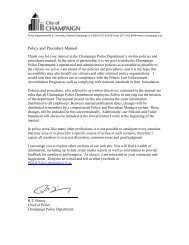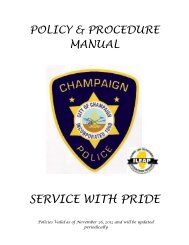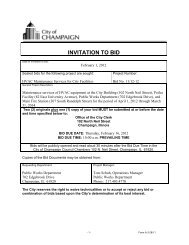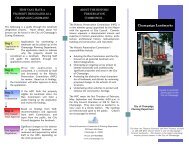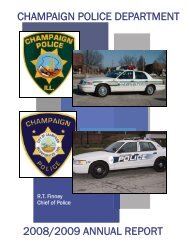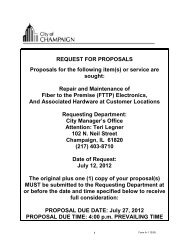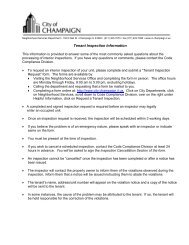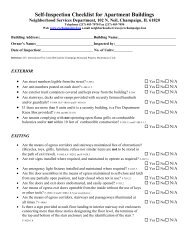Washington Street West watershed - City of Champaign
Washington Street West watershed - City of Champaign
Washington Street West watershed - City of Champaign
- No tags were found...
You also want an ePaper? Increase the reach of your titles
YUMPU automatically turns print PDFs into web optimized ePapers that Google loves.
Draft Report<strong>West</strong> <strong>Washington</strong> <strong>Street</strong> Watershed Master Planreduce stormwater pollution. Implementing this type <strong>of</strong> design in the <strong>West</strong> <strong>Washington</strong><strong>Street</strong> <strong>watershed</strong> would be consistent with recommendations in the Copper SloughWatershed Master Plan prepared for the <strong>City</strong> <strong>of</strong> <strong>Champaign</strong>, and would also help the<strong>City</strong> demonstrate its continued compliance with its NPDES municipal stormwaterpermit.4.6 STATUS OF THE COPPER SLOUGHWater pollution control programs are designed to protect the “designated uses” <strong>of</strong> the waterresources <strong>of</strong> the state. Each state has the responsibility to set water quality standards that protectthese designated uses, which include aquatic life, wildlife, agricultural use, primary contact (e.g.swimming, water skiing), secondary contact (e.g. boating, fishing), industrial use, drinking water,food-processing water supply, and aesthetic quality.Section 303(d) <strong>of</strong> the federal Clean Water Act (CWA) requires states to identify waters that donot meet applicable water quality standards or do not fully support their designated uses. Statesare required to submit a prioritized list <strong>of</strong> impaired waters, known as the 303(d) List, to theUSEPA for review and approval.The CWA also requires that a Total Maximum Daily Load (TMDL) be developed for eachpollutant <strong>of</strong> an impaired waterbody. The establishment <strong>of</strong> a TMDL sets the pollutant reductiongoal necessary to improve impaired waters.The Copper Slough is currently not listed as a 303(d) impaired stream. There is no evidence toidentify the <strong>West</strong> <strong>Washington</strong> <strong>Street</strong> <strong>watershed</strong> as a possible source <strong>of</strong> stormwater contaminants;however, stormwater run<strong>of</strong>f in the <strong>West</strong> <strong>Washington</strong> <strong>Street</strong> <strong>watershed</strong> will contribute urbanrun<strong>of</strong>f to the Copper Slough, which typically carries known pollutants, such as nutrients (nitrogenand phosphorus), heavy metals (lead and copper) and bacteria (fecal coliform) from animal waste.The Copper Slough does not currently have TMDLs established for the downstream reach andthere is no timetable for TMDL development for this <strong>watershed</strong>. However, the IllinoisEnvironmental Protection Agency (IEPA) may choose to add the Copper Slough to their TMDLWatershed List in the future. At this time, there is no indication when (and if) that will occur.As part <strong>of</strong> the <strong>City</strong>’s NPDES municipal stormwater permit (ILR40), the <strong>City</strong> is expected toaddress stormwater quality to receiving streams. Where possible, BMPs should be implementedin new and existing developed areas to reduce the pollution potential from urban run<strong>of</strong>f. As theCopper Slough is not listed as an impaired stream, the <strong>West</strong> <strong>Washington</strong> <strong>Street</strong> <strong>watershed</strong> wouldbe an ideal location in which to practice measures aimed at reducing pollution throughstormwater BMPs as a proactive measure.4.7 <strong>West</strong> <strong>Washington</strong> <strong>Street</strong> Watershed BaseflowThere is significant baseflow within the <strong>West</strong> <strong>Washington</strong> <strong>Street</strong> trunk storm sewer during dryweather, sometimes flowing a third full a week after a precipitation event. There are no identifiedsources <strong>of</strong> this baseflow, although possible water main leaks, groundwater infiltration and othersources are all being considered by the <strong>City</strong>. Sewer televising has not produced any clear sources<strong>of</strong> storm sewer inflows, although the <strong>City</strong> will continue to investigate the sewers in this <strong>watershed</strong>in order to reduce the baseflow in the <strong>West</strong> <strong>Washington</strong> <strong>Street</strong> trunk sewer.September 20094-6Clark Dietz, Inc.


